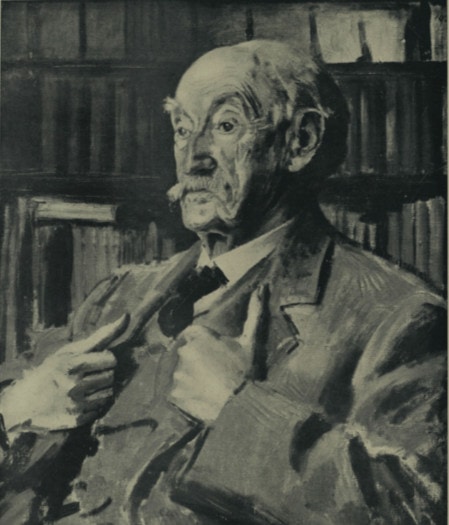By Daniel Mercieca, Gale Ambassador at Durham University
“She was not an existence, an experience, a passion, a structure of sensations, to anybody but herself. To all humankind besides Tess was only a passing thought. Even to friends she was no more than a frequently passing thought.” [i]
The well-trodden Dorsetshire heathlands, bustling rustic communities and evanescent ghosts from Thomas Hardy’s folkloric world, Wessex, continue to impress memories of English rural heritage. Hardy’s sensitive capturing of ‘mere impressions of the moment’ in prose and poetry; the cascade of raindrops on a gate, hazy warmth of a barn dance or ghostly silhouette of a horse rider in sea mist, reinvigorates our appreciation of ordinary experience [ii]. This year marks the 90th anniversary of Hardy’s final collection of verse, Winter Words in Various Moods and Meters (1928), whose sombre cadences echo amongst later generations of modern poets and can be found in The Times Historical Archive. The continual resurgence of Hardy’s works in dramatic and televisual adaptations, modern poetry and National Trust Heritage fosters a Wessex mythology which remains vibrant today.
Inspired by the ongoing legacies of the author’s words, this blog post questions why his cunningly irregular style lingers in our cultural and literary imagination. I will traverse Hardy’s Wessex topography by exploring serialisations of the novels including The Mayor of Casterbridge (1886) in British Library Newspapers, reviews by later poets and prominent literary critics from Nineteenth-Century Collections Online as well as theatre and film adaptations reviewed in The Times Digital Archive.

Graphic, 24 Apr. 1886. British Library Newspapers, http://tinyurl.galegroup.com/tinyurl/6VQ4F8#.WvMzgiXP7nM.link.
Serialised Fiction
Whilst popularised for their tragic figures and estranged romance plots, Hardy’s novels were first serialised in literary magazines and newspapers including The London Graphic. The winding country paths and convoluted plot of Tess of The D’Urbervilles (1891) is well suited to the episodic style of magazine publication, preserving and mourning for the country’s farming communities during a period of rapid industrialisation. Despite the novel’s thorny reception for its harrowing content, shattering the sentimental marriage-resolution of much late Victorian fiction including the works of Elizabeth Gaskell and George Elliot, Tess altered the course of the novel through its rendition of the nation’s ‘metamorphic classes of society’.[iii] In the preface to the Second Edition of the novel, recorded in The Illustrated London News, the author defends it against genteel criticism of ‘such vulgar articles as the Devil’s pitchfork, a lodging-house carving knife and a shame bought parasol appearing in a respectable story’, illustrating its jagged content as representative of deprived rural economies.

Graphic, 8 Aug. 1891. British Library Newspapers, http://tinyurl.galegroup.com/tinyurl/6V76DX#.WvIQ-K7WzNY.link
Hardy’s rather undervalued novel, The Pursuit of the Well Beloved (1892), was published in twelve weekly instalments in The London Illustrated News and marks his transition from fiction to poetics with its looser and more experimental style. As a proto-modernist novel, The Pursuit of the Well Beloved is Hardy’s meditation on changes in art and the aesthetic representation of women and landscapes during the late nineteenth century. The novel’s sculpted prose depicting the South-Western cliffs, ‘like a miniature forest of oolite, the plethora of freestone in the locality placing a carved memorial within the reach of all’, illustrates coastal elegance with an elegiac tone, mourning the inherent beauty of nature against the emerging elitism of Modernist Art. Hardy’s style extends to the crafted typography of the newspaper’s columns which embody the stratigraphic texture of the cliffs, as well as the series of pencil sketches which capture the novel’s striking visual imagery. The protagonist of The Well Beloved, a stone sculptor called Joycelyn Pierston, is a semi-autobiographical portrait of Hardy as an architect of Churches and of language, which is visualised by their physical resemblance in the newspaper’s sketches.

Illustrated London News, 10 Dec. 1892, p. 741+. The Illustrated London News Historical Archive, 1842-2003, http://tinyurl.galegroup.com/tinyurl/6UuQG0#.WvG2powPT2U.link
Poetic and Critical Echoes
Hardy published over 900 short poems between 1898 and 1928 which focus on strikingly emotional yet ordinary moments in his life where the past erupts into the present. Some of these poems were published in The Daily Telegraph. Centring on memory, these poems seem to grow in significance and meaning years after the author’s death, which is made apparent by their influence on the modern poet Phillip Larkin in his 1968 BBC Radio 4 Interview, ‘A Man Who Noticed Things’. Larkin notes of Hardy’s collected poems that ‘there is a little spinal cord of thought and each has a tune of its own’, and that ‘immediately you begin a Hardy poem your own inner response begins to rock in time with the poem’s rhythm’, implying their reverberating emotional resonances. Devonshire Poet and literary critic, Patricia Beer further praises Hardy’s ‘Convergence of the Twain’, (a poem about the sinking of the Titanic) amongst other poems in her 1984 Article in The Listener. She writes, ‘as usual he observes the unobservable; it needed his to invent the practical, precise underwater scenes in the days when nobody had photographed the bottom of the ocean’, positing his ability to produce revelatory moments of vision from a keen perception of things.

Whilst facing seething criticism for ‘corrosive pessimism’ and the shocking and irreligious content of Tess and Jude the Obscure (1895), Hardy’s writing has been valued by later literary critics for its enduring stylistic effects. G.K. Chesterton’s 1928 article in The Illustrated London News, identifies that Hardy ‘had a great love for shapes that are not shadows. He can make a picture with something more than a picture because it is not flat. It is like a picture full of coloured statues and has the depth of the stage’. Chesterton’s comments emphasise the dynamism of Hardy’s plain diction, which takes influence from John Ruskin’s Gothic Architectural style in The Stones of Venice, the Gothic and Greek Tragedy to penetrate the hidden pathetic dimensions of everyday life.[i] Frank Kermode’s 1975 article on the Wessex Edition of the novels draws attention to Hardy’s idiosyncratic style and dialectics as inventive ways of expressing variable inner moods. Kermode argues that Hardy has ‘a Shakespearean reticence, very disarming to all critics and concluders, yet demanding constant reinterpretation’, capturing the writer’s ability to surprise and suspend our disbelief across multiple re-readings.

Stage and Screen Adaptations
Hardy’s novels have been reinterpreted in various performances over the twentieth and twenty first-centuries, most significantly by The Hardy Players, an amateur dramatic society in Dorset depicted here in a 1924 Times review. Hardy’s inspiration for the figure of Tess came from local milkmaid Augusta Way, whose daughters Gertrude and Norrie Woodhall were selected to perform as characters from the novel. On her 100th birthday, Norrie’s wish was the Hardy Players to be reformed as The New Hardy Players, who remain active today with poetry readings, tours and dramatisations. Hardy’s novels translate particularly well to film adaptation, including Roman Polanski’s Tess (1971), reviewed by The Sunday Telegraph. Nastassja Kinski’s forlorn demeanour, clad in brown rags against foggy backdrops, reflects Tess’s ghostly alienation from her own narrative in the novel, which is heightened by Polanski’s themes of psychological disturbance and violence.

Thomas Hardy’s Wessex mythology inspires literary, dramatic and filmic continuities internationally. What is significant about Hardy’s literary impressions is their preservation of a rural culture and way of life, increasingly subject to coastal erosion, urbanisation and consumer culture.
By spending a few minutes reading a Hardy poem through Gale Primary Sources, you may begin to notice new connections and significances outside of the haste and demands of our contemporary digitised and post-industrial world.
Blog post cover image citation: Portrait of Thomas Hardy by Augustus John, A. R. A. By Courtesy of the Fitzwilliam Museum and the “Times” ‘copyright’. “A Famous Artist’s Portrait of the Greatest Living English Writer.” Illustrated London News, 23 Feb. 1924, p. 318. The Illustrated London News Historical Archive, 1842-2003, http://tinyurl.galegroup.com/tinyurl/6V5co2#.WvIBGQ1dn3Y.link .
[i] Hardy, Thomas, Tess of the D’Urbervilles, third edition (London: Norton, 1991), p. 115.
[ii] Hardy, Thomas, ‘1912 General Preface to the Wessex Edition to the Novels’, in Harold Orel, ed., Thomas Hardy’s Personal Writings (New York: Springer, 2016), p. 49.
[iii]Hardy, The Hand of Ethelberta, quoted in Stephen Regan, ‘Far From the Madding Crowd: A Novel in History’ in The Nineteenth-Century Novel: Realisms, ed. by Delia Correa Soussa (New York: Routledge, 2013), p. 348
[iv] Ruskin, John, The Stones of Venice, Volume II, in The Works of John Ruskin, third edition, ed. by E.T. Cook and Alexander Wedderburn (George Allen: London, 1888), p. 239.


